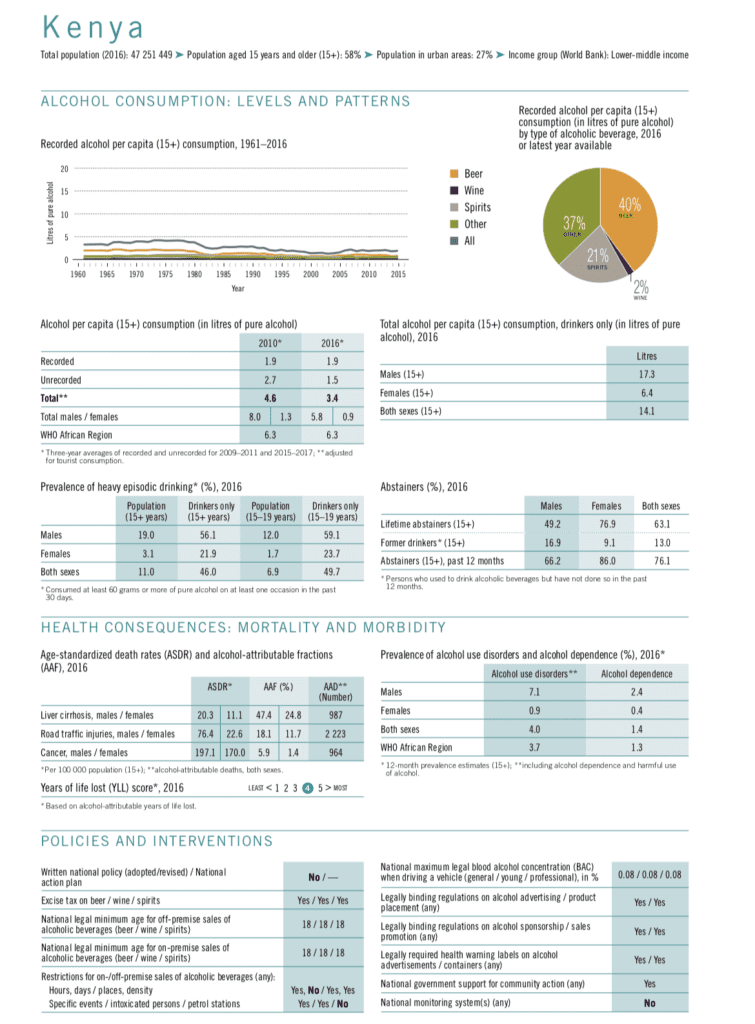Alcohol harm affects entire generation
Kenya’s Deputy President attributes the rise of the illicit brewing industry to the failure of provincial governments to safe-guard the wellbeing of their people. The BBC reported that Deputy President Gachagua was criticizing the number of business permits issued for alcohol retailers.
Licensing every kiosk, every outlet to be a bar and restaurant, is a way of destroying an entire generation and that is not right.”
Deputy President, Geoffrey Gachagua, Kenya
Easy and wide alcohol availability is a major driver of alcohol harm. And placing common sense limits on the presence of alcohol in communities is one of the three alcohol policy best buys, recommended by the World Health Organization (WHO).
The alcohol policy ‘best buys‘ are scientifically proven the most cost-effective, feasible, and impactful alcohol policy solutions to reduce alcohol consumption at the population level and thus prevent and minimze alcohol harm.
Enacting and enforcing limits on commercial or public availability of alcohol through laws, policies, and programmes are important ways to prevent and reduce alcohol harm. Such strategies provide essential measures to prevent easy access to alcohol by young people and other vulnerable and high-risk groups, according to the WHO.
Movendi International provides a database of more than 700 articles, policy news, and science updates about alcohol availability, including best practice policies from around the world.
For instance, reducing the supply of alcohol by limiting the physical availability will reduce overall alcohol consumption in thus alcohol harm. This can be achieved, among other solutions, through reducing alcohol outlet density:
- How Alcohol Outlets Affect Neighborhood Violence, by Stewart, PIRE
- The association between alcohol outlet density and assaults on and around licensed premises, by Burgess and Mofett, 2011
The BBC also reported that the governor of Nyandarua County, Moses Badilisha, was emphasising the need to consider alcohol in relation to its impact on the development of the country:
I will not relent in fighting against alcohol… within Nyandarua County and I’m deploying all laws and policies which address the menace,” said Moses Badilisha, the governor of Nyandarua County, as per BBC reporting.
It is no longer tenable to address the liquor licensing as merely a social and revenue issue, but one that’s now touching on the very survival of youth and potential of our county to develop and sustain a functional population.”
Moses Badilisha, Governor, Nyandarua County, Kenya
Leading by example
Both the current President William Ruto and Deputy President Gachagua have been at the forefront of alcohol prevention efforts in Kenya. The President in particular set the tone for the country’s approach to alcohol harm by being vocal in his efforts to denormalise alcohol, unveiling their plans to mentor a new generation of leaders. Preventing the harm caused by Big Alcohol as well as illicit alcohol are key features in these efforts.
President Ruto has requested for Members of Parliament to be role models by remaining alcohol-free at work. Mr Ruto and his deputy live alcohol-free and believe cutting down or quitting alcohol is better for leadership and productivity.
The governments needs to ensure cohesion between different levels of response to alcohol harm
The Deputy President’s new policy comes before the backdrop of alcohol being one of the biggest obstacles to development according to former President Uhuru Kenyatta’s government.
WHO’s Global Alcohol Status Report in 2018 reported that almost half the youth (49.7%) in Kenya engage in binge alcohol use.
The report also placed the country on the higher end for years of life lost due to alcohol score.
As reported by Movendi International, the administration has been calling for collaboration between the national and county governments to protect Kenya’s people against alcohol harm since as far back as 2019.
The extent of the alcohol harm in Kenya is such that it has become one of the leading factors for children dropping out of school.
People want change
The massive harm to the people of Kenya caused by alcohol requires urgent and comprehensive action, integrating action on all alcohol policy best buys and action on all levels. Therefore a written national alcohol policy is needed to accelerate action and to ensure greater cohesion between national and local governments. The aggressive tactics and unethical business practices of the alcohol industry necessitates the need for a united effort.
All initiatives to improve and accelerate alcohol policy development have so far been met with heavy lobbying and resistance by alcohol companies and their lobbying front groups.
In spite of this resistance, the new effort to limit alcohol availability in cities and towns by the national government shines a hopeful light for the future.
For local people such as Rosemary Kimani, who lost her husband to alcohol and now has to suffer seeing her children struggle with alcohol use disorder, change cannot come soon enough. To her at least, the nature of the problem, alcohol, is clear enough, as the BBC reports:
It’s a national disaster”.
Rosemary Kimani
Sources
WION: “Kenya to Solve Its Alcohol Problem With One Bar per Town Plan“
BBC: “Kenya’s Plan to Curb Alcohol Abuse: One Pub per Town“
Nation: “Alarm as Central Suffers the Brunt of Alcohol Abuse“

